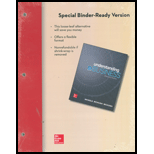
To think critically about: The opinion of the manager with reason, whether to work for a large business or small business, private or public company as an officer or out in the field.
Introduction:
The bundles of operations (production or service) which lead to earning of profit are collectively known as business. Managers are responsible for the management of any business.
Explanation of Solution
Given information:
The different options are given related to types of business, a manager wants to join.
Explanation:
The various types of business, a manager wants to join are mentioned below:
Large business: The manger would likely to work for a large business, as it will provide scope of growth and development for the manager. Manager will get proper training and orientation.
Public company: The manger would like to work for a public company as it provides many benefits as compared to the private company. For example: Job security, perks and other benefits.
In an office: The manager is at the middle level post of the business. So, the manager must have to work in an office rather than out in the field. In case of female employee, office work is preferred as compared to field work.
The manager would like to work for a large business, public company and as an officer.
Want to see more full solutions like this?
Chapter 7 Solutions
UNDERSTANDING BUSINESS (LL) >CUSTOM<
- During the Decision Stage of the Strategy Formulation framework, the focus is upon generating feasible alternative strategies by aligning key external and internal factors. True or False? Question 47Select one: True Falsearrow_forwardWhich of the following is NOT a reason to outsource non-critical activities? Question 49Answer a. Lower costs b. Flatten organization strategy c. Increase competitive responsiveness d. Increase internal bureaucracies Clear my choicearrow_forward_____________ addresses changes within the internal and the external business environment, and can range from strikes to natural disasters, bereavement and other occurrences Question 50Answer a. Strategic Planning b. Contingency Planning c. Disaster Planning d. Organizational Planning Clear my choicearrow_forward
- _____________ is the name given to the firm investing in international operations Question 51Answer a. Host Company b. Global Company c. International Company d. Parent Company Clear my choicearrow_forwardWhich of the following tools are the most appropriate for analyzing the macro-environment? Question 53Answer a. SWOT analysis b. Value Chain Analysis c. Benchmarking d. PESTLE frameworkarrow_forward________________is called the “action stage” of strategic management. Question 48Answer a. Strategy management b. Strategy implementation c. Strategy evaluation d. Strategy formulationarrow_forward
- When evaluating an organization's strategy, it is important to note that corrective actions are almost always needed except when internal and external strategic positions have not changed. The basis of any review would require the redevelopment of a: ____________________________ Question 31Answer a. Value Chain Analysis b. SWOT Analysis c. EFE and IFE Matrix d. PESTLE Analysisarrow_forward___________________refers to the process of redesigning a vertical organisation along its horizontal workflows and processes. Rather than focusing on narrow jobs structured into distinct functional departments, they emphasise core processes that cut horizontally across the organisation and involve teams of employees working together to serve customers Question 23Answer a. Workforce Configuration b. Structural Reengineering c. Business Process Reengineering d. Horizontal Configurationarrow_forwardAlternative plans that can be put into effect during strategic evaluation if certain key events within the strategic plan do not occur as expected. Question 20Answer a. Contingency Plan b. Strategic Evaluation Plan c. None of the provided options d. Emergent Planarrow_forward
- Assuring results is an attainable habit of a strategic leader only if a strategic leader is intentional in developing high performing organisations. Strategic leaders must be intentional in this because they can shape the organisational culture, or the culture may ‘manage’ the leader. One way to do this is to ______________ Question 17Answer a. Develop a Strategic Leadership plan b. Develop a Strategic Implementation Plan c. Implore levers of change d. Develop a Vision Statementarrow_forwardThis stage of the strategic management process, provides a control loop in determining the successful implementation of corporate, competitive, functional and global strategies. It seeks to ascertain the nature of the change betweenplanned strategies and its resultant emergent strategies Question 16Answer a. Strategic Advantage b. Strategic Formulation c. Strategic Implementation d. Strategy Evaluationarrow_forwardHigher product quality than rivals, Superior on-time delivery, A bigger market share, are all examples of: Question 11Answer a. Financial objectives b. Competitive Advantage objectives c. Components of Mission Statement d. Strategic objectivesarrow_forward
 Understanding Management (MindTap Course List)ManagementISBN:9781305502215Author:Richard L. Daft, Dorothy MarcicPublisher:Cengage Learning
Understanding Management (MindTap Course List)ManagementISBN:9781305502215Author:Richard L. Daft, Dorothy MarcicPublisher:Cengage Learning Management, Loose-Leaf VersionManagementISBN:9781305969308Author:Richard L. DaftPublisher:South-Western College Pub
Management, Loose-Leaf VersionManagementISBN:9781305969308Author:Richard L. DaftPublisher:South-Western College Pub Foundations of Business (MindTap Course List)MarketingISBN:9781337386920Author:William M. Pride, Robert J. Hughes, Jack R. KapoorPublisher:Cengage Learning
Foundations of Business (MindTap Course List)MarketingISBN:9781337386920Author:William M. Pride, Robert J. Hughes, Jack R. KapoorPublisher:Cengage Learning Foundations of Business - Standalone book (MindTa...MarketingISBN:9781285193946Author:William M. Pride, Robert J. Hughes, Jack R. KapoorPublisher:Cengage Learning
Foundations of Business - Standalone book (MindTa...MarketingISBN:9781285193946Author:William M. Pride, Robert J. Hughes, Jack R. KapoorPublisher:Cengage Learning




